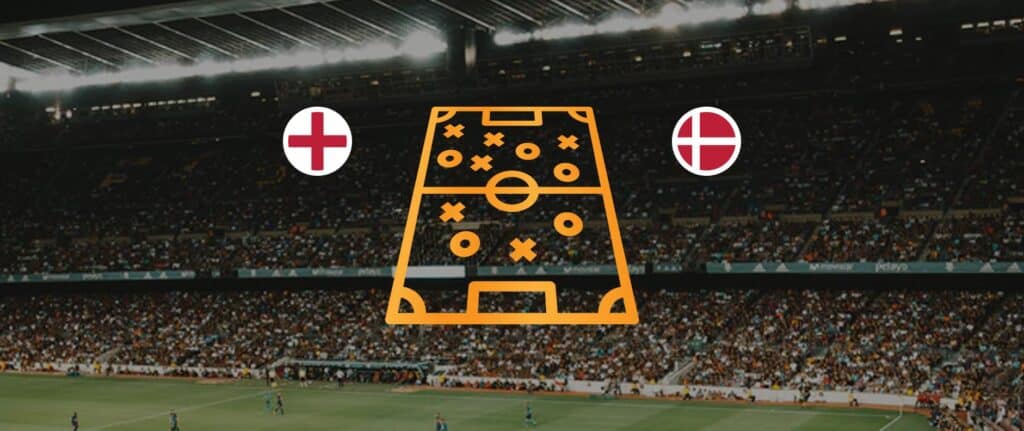Once again, Wembley stadium was the scene of the second semi-final of the Eurocup, hosting the duel between England and Denmark, 2 teams which showed hierarchy and a well-honed strategic game.
England used a 1-4-3-3 tactical system throughout the first half and 24 ‘of the second period where they switched to a 1-4-2-3-1 tactical system. Already in the alternate supplementary stage the tactical system 1-4-2-3-1 ended and the competition ended with a tactical system 1-5-4-1 protecting the scoreboard that was in his favor. Despite being at a disadvantage, at 39 ‘he managed to tie the game through Simón Kjaer.
England Initial Tactical Disposition

Start of Play / England
Offensive Actions / England
On the side of Denmark, who gave the initial blow (at 30 ‘of the First Half a Free Kick executed by M. Damsgaard), they presented a tactical system 1-5-4-1 compact, solid, and difficult to cross. At 20 ‘of the second half, they alternated towards a 1-5-3-2 tactical system reaching overtime with the system he started (1-5-4-1).
Initial Tactical Provision of Denmark

Start of Play / Denmark
Offensive Actions / Denmark
If we try to understand the existence of supremacy between both teams, my opinion is “NO”. It was a duel thought, worked and strategically specified by both coaches.
The data that sets the trend is the number of passes that England made in relation to Denmark, when we count the total volume we will find a difference of more than 200 passes in favor of England (714 vs 494). An indicative perspective that a game should have made of the movement of the ball from one lane to another frequently, since the block of 1st, 2nd and 3rd line of Denmark was almost impossible to violate, therefore the home team tried to find, from the beginning of the game, to Henry Kane who moved into the right lane to receive the long shots from Pickford or the defensive line. Needless to mention, if the number of passes increases, it is an indicator that reflects possession of the ball in favor of the team with the most number of passes (England 58% vs Denmark 42%).
R. Sterling marked a trend with movements that he performed from inside / outside. Thus, he received in the outer central (or right) lane and drove diagonally towards the center of the area in order to connect with a teammate from a diagonal pass that breaks the defensive line from Denmark or define by shot or center.
Next, you will see the corresponding actions R. Sterling:
The game was so strategic that no advantages were taken in friction-related events such as duels and recovered balls where the trend of both teams was similar.
Denmark statistically had a lower volume of events but was effective in its actions.
One of the ideas that was repeatedly evidenced by Denmark goalkeeper K. Schmeichel was the direct intermediate starts of play looking for both 5- J. Maehle on the left and 17- J. Larsen on the right who were ahead more beyond the first line of English pressure in order to progress in the field. At times, the exit was also directed towards player No. 23 J Hojbjerg, who was already more advanced with his back to the goal to support or turn and face it.
The following are the actions of Denmark goalkeeper K. Schmeichel:
To conclude this analysis, we invite the reader to enjoy the best moments of the game where England made it to the final, in search of the first European Championship in its history.

Comments are closed.